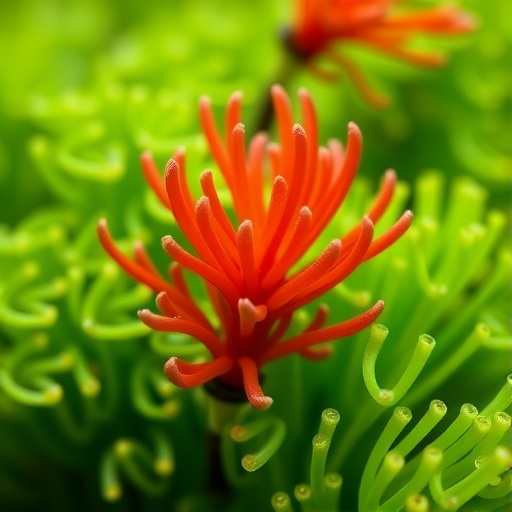Recent advancements in the field of microalgal biotechnology have illuminated significant pathways for optimizing the accumulation of astaxanthin, a potent antioxidant with numerous health benefits, in freshwater green microalgae. A pioneering study led by Kumar et al. has brought to light the intricate relationship between various physicochemical factors and the biosynthesis of astaxanthin in a newly isolated strain of microalgae known as Desmodesmus sp. PLM2. The research not only sheds light on optimizing growth conditions but also underscores the pressing need for sustainable production methodologies as the demand for natural carotenoids rises.
Astaxanthin, a member of the carotenoid family, is renowned for its possible health benefits, including anti-inflammatory and antioxidant properties. The compound finds wide applications ranging from nutraceuticals and cosmetics to aquaculture, where it significantly enhances the coloration of fish. However, the natural extraction of astaxanthin from traditional sources can be labor-intensive and unsustainable. Thus, researchers have turned their attention to microalgae as promising biofactories for large-scale astaxanthin production.
In their comprehensive investigation, Kumar and colleagues meticulously explored the optimization of physicochemical factors, which are crucial for enhancing astaxanthin yield in Desmodesmus sp. PLM2. The study highlights various environmental conditions, such as light intensity, temperature, and nutrient availability, and their respective impacts on the algal growth and carotenoid biosynthesis. By fine-tuning these parameters, the researchers managed to significantly boost the astaxanthin concentration, suggesting a scalable pathway for future commercialization.
Moreover, the study utilized state-of-the-art analytical techniques to quantify and characterize the accumulated astaxanthin in the microalgal samples. High-performance liquid chromatography (HPLC) emerged as a pivotal method for precise quantification, allowing the researchers to validate their findings rigorously. Additionally, spectrophotometric assays complemented these analyses, providing a more in-depth understanding of the pigment’s absorption properties and potential health implications.
As part of their findings, Kumar et al. discovered that light quality played a vital role in astaxanthin accumulation. Different wavelengths were tested, revealing that blue and red light significantly enhanced the synthesis of carotenoids compared to other light spectrums. This discovery paves the way for the development of photobioreactors optimized for specific light conditions tailored to maximize astaxanthin yield, thereby driving down production costs.
Temperature emerged as another critical factor influencing astaxanthin biosynthesis. The study found an optimal temperature range that favored not just growth but also the metabolic processes leading to carotenoid production. Understanding the thermal thresholds for Desmodesmus sp. PLM2 is pivotal for scaling up production in controlled environments, particularly when aiming for commercial applications.
Nutrient concentration is fundamental in the growth of microalgae and, consequently, the synthesis of astaxanthin. The study indicated that varying nitrogen and phosphorus levels profoundly impacted both algal biomass and astaxanthin yield. By optimizing these nutrients, researchers could create a balanced culture medium that promotes growth while also ensuring maximum carotenoid production.
Kumar et al. also investigated the role of stress conditions in enhancing astaxanthin synthesis. Exposure to stressors such as high salinity or UV radiation prompted the microalgae to produce more carotenoids as a protective mechanism. This finding raises intriguing questions regarding the potential of using stress-induced cultivation practices in commercial algal farms, which could push the boundaries of biotechnological applications in astaxanthin production.
The results from this study contribute immensely to the existing body of knowledge, paving the way for further research into the metabolic pathways involved in carotenoid biosynthesis in microalgae. A deeper understanding could unlock new genetic engineering avenues, enabling the development of hyper-accumulating algal strains tailored for industrial-scale applications.
Conclusively, the implications of this research extend beyond mere academic interest; they highlight a sustainable future for astaxanthin production that could diminish reliance on synthetic alternatives. As global health trends increasingly favor natural compounds, the optimization strategies developed by Kumar et al. could lead to an expanded market for plant-based dietary supplements, functional foods, and aesthetics industries.
The study encapsulates a timely consolidation of current analytical techniques, illustrating their utility in enhancing our understanding of microalgal biology. Readers from diverse fields—be it environmental science, pharmacology, or agricultural biotechnology—will find valuable insights that can drive innovative research and application strategies.
To underpin the significance of this research, collaborative efforts amongst scientists, policymakers, and industry stakeholders will be essential. A concerted push towards large-scale applications could see Desmodesmus sp. PLM2 becoming a pivotal player in the nutritional and cosmetic industries. Such collaboration may also advance public awareness regarding the benefits of microalgal products, effectively merging scientific discovery with socioeconomic outcomes.
With sustainable practices at the forefront of global initiatives, the potential for harnessing natural resources through biotechnology couldn’t be more relevant. The groundwork laid by Kumar et al. provides a foundation for further exploring microalgae as not just a source of valuable compounds but as a cornerstone of sustainable development in biotechnology.
As the demand for natural alternatives continues to surge, the optimized production of astaxanthin stands to transform agricultural and pharmaceutical spheres alike. The momentum generated by these findings holds promise, igniting discussions around biotechnological innovations that could redefine industry standards and consumer choices globally.
This journey into the realm of microalgae and astaxanthin accumulation heralds a new era in biotechnology, underscoring the potential for eco-friendly solutions to modern challenges. As we embrace this knowledge, the pathway toward sustainable production systems that benefit both humanity and the planet remains open and inviting.
Subject of Research: Optimization of physicochemical factors for enhanced astaxanthin accumulation in microalgae.
Article Title: Optimisation of physicochemical factors for enhanced astaxanthin accumulation in newly isolated freshwater green microalgae Desmodesmus sp. PLM2: insights from current analytical techniques.
Article References: Kumar, S., Kumar, R., Diksha et al. Optimisation of physicochemical factors for enhanced astaxanthin accumulation in newly isolated freshwater green microalgae Desmodesmus sp. PLM2: insights from current analytical techniques. Int Microbiol (2025). https://doi.org/10.1007/s10123-025-00738-4
Image Credits: AI Generated
DOI: https://doi.org/10.1007/s10123-025-00738-4
Keywords: Astaxanthin, Microalgae, Desmodesmus, Biotechnology, Carotenoids, Sustainable Production, Analytical Techniques.




